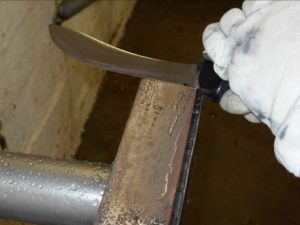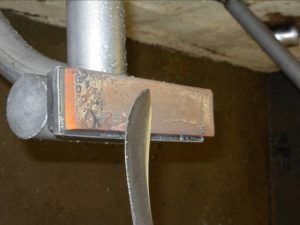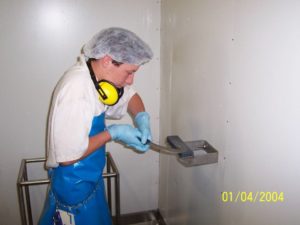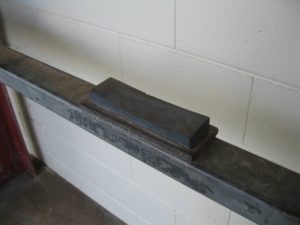The Oilstone
Man-made oilstones are made from silicon carbide and aluminium oxide. The abrasive grit is pressed and heated like a ceramic to a high temperature until it is effectively a stone. These materials cut faster than the natural stones but require a lighter touch to achieve the same results.
You can use an oilstone or whetstone to shape or bevel the sides of the knife blade which forms the edge. This process is called honing the blade.
A larger two layer oilstone is the easiest to use. One side should be a medium coarse abrasive and the other medium fine.
Honing oil, (white oil is a good choice) as well as water and detergent, are used on the oilstone to stop the stone from clogging up with small pieces of metal from the knife. Do not use lubricating oils for honing as they form a sludge which makes it difficult to cut the metal of the blade. They also tend to clog the porous feature of stones.
A stone clogged with sludge or fat will appear glossy and be of little use to you.
Hot water and a strong detergent will get it out. Do not use the caustic in the hook shed to clean stones as it is extremely dangerous and against company safety rules. Caustic reacts with moisture and fat to create heat. If it comes into contact with you it’ll burn a hole in your skin.
- Place the stone on a clean surface or stainless steel frame (stone holder) to eliminate cross-contamination. Use a clean piece of towelling to prevent the stone slipping.
- A fixed stone holder is the safest and best way to secure the stone.
- Clean the knife before sharpening.
- Clean the stone after each use to remove fat build-up. (If hot water will not remove fat build up contact maintenance to dip in acid wash with the rollers) This will add ‘bite’ to your stone.
- Store the stone in a clean area.
When honing, the blade should be drawn across the oilstone from the heel to the point, as shown in the following diagram. You must keep the knife at the same angle that it was ground on the grinding stone. Do one side and then the other, in that order, or an uneven blade will occur.


Knife sharpened on oilstone

Notice the lifting motion without changing the bevel angle to obtain a sharp edge on a curved blade

Sharpening stone
Ensure that the blade is evenly sharpened on both sides. The knife is now ready to be steeled.
